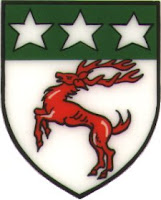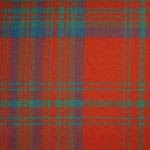It's not clear when my second great grandfather Marcus' younger brother James (1796-1878) travelled to Vermont from Donegal, or whether he travelled with Marcus and Mary Ann and their young family, but arrive in Vermont he did. They were all first in South Hero, on Grand Isle, an island in Lake Champlain.
Luckily, there are many records about my 2nd great uncle, starting with this first fantastic find. In his 2002 book,
Pre-famine Irish in Vermont, 1815-1844, Vermont historian Vincent Edward Feeney writes about James:
"Without priests, too many Catholics were being married by justices of the peace, and many drifted away from the Church. One had even became a prominent Protestant clergyman. This was James Daugherty. 50 From County Derry, Daugherty had been raised “a conscientous Catholic,” and emigrated with his two brothers at about age 20 in 1819 to South Hero, Vermont. There, under the instruction of a Congregational minister, the Reverend Asa Lyon, he prepared to enter college. Lyon must have been a profound influence on young Daugherty, for when the Irishman eventually graduated from the University of Vermont in 1830 he entered the ministry. He spent the next thirty-five years first as the Congregational pastor in Milton, and later in Johnson."
That's right, he left the Catholic Church, became a Congregational minister, married (twice) and had children. One biographical sketch includes this passage about his decision to leave the Catholic faith:
'His parents were devoted Catholics and he was reared in a conscientious regard of that faith, but as he grew to years he felt a want un-supplied. Having heard from the Scotch Presbyterians the doctrine of salvation by faith, "That", said he is what I want that; I can do, I can believe. He was converted while yet in connection with the church of his parents, and did not change his relation till after removing to this country at the age of twenty three.'
Another reference to his faith appears in one of the eulogies given after his death:
'Reared in the Roman Catholic church, he very early became dissatisfied with that faith and at length deliberately and utterly repudiated it."
That's pretty definite. James' parents were both deceased in Donegal by 1830, so they didn't know about his change in faith. Imagine disclosing that in a letter home that would have taken months to arrive at its destination! James graduated from the University of Vermont in 1830, before then studying theology, during which time he also taught at the well-respected in its time Shefford Academy in Frost Village, now part of St-Hyancinthe in Shefford, Quebec. He ultimately received his doctorate in divinity, and was known around the towns of Johnson and Milton and beyond as Dr D.
James was a man of strong conviction. As the
University of Vermont notes in its obituary, his home was a station on the underground railway as former slaves made their way to Canada. Incredible! I'm very proud to be related to such a very fine man. There are several items about James, searchable on Google Books.
James married twice, first to Celia Hall (1800-1836) a daughter of the longtime South Hero town clerk in 1832. James and Celia had two daughters, Sarah Curran (1834-1861) and Isabella Celia (1836-1894). Sadly, Celia died five days after Isabella's birth. Sarah was named after the great love of the Irish patriot,
Robert Emmet. James married again, a year later, to a widow, Mary Hoxie Drake (1795-1881), and together they had one daughter, Mary Louisa (1838-1894). None of his daughters married or had children, so James left no descendants after their deaths.
At this point, I'll say that yes, the names James, Isabella and Mary Louisa appear over and over again among my Dougherty ancestors. Some readers may recognize these names
from an earlier post. And you'll see these names crop up again, as my stories continue. In fact, the parents of Marcus and James and their siblings are--wait for it--James Dougherty and Isabella McLaughlin. And yes, it does get confusing.
The border between Vermont and Quebec was transparent in the late 18th to mid 19th centuries. People crossed back and forth often and easily. One reason was that there were few Catholic priests in Vermont early on. There were many Irish Catholics who settled in Vermont. So while we know that James taught at the Shefford Academy, it seems that he was also a travelling preacher at one point. A few years ago in Granby, my brother came across a plaque outside what had been a congregationalist church and is now a United Church on Main Street. Here is part of that plaque noting that James had preached at that church. James no doubt visited with brother Marcus and his family in Granby, as well as their nephew Marcus Doherty, who lived in Granby for a time.
 |
| Plaque, Granby United Church |
At his funeral following his death from consumption on 10 Jun 1878, James was eulogized at length. Both his death and his funeral were reported in the local media. In its June 21, 1878 edition, The Burlington Weekly Free Press published a lengthy item. See the fourth column
here. This mentions that James was born in Fairmount, County Down, Ireland. This is up for debate. Other sources report that he was born in Park, Banagher, Donegal, near which there is the town of Learmount. Then, in its June 28, 1878 edition, a second eulogy was published in the same newspaper. See the third column
here. Aside from the many references to his life as a clergyman, there are also fascinating insights into who he was as a man.
 |
| Side of family grave marker |
James was buried at the Whitting Hill Cemetery in Johnson, Lamoille, Vermont, with his daughters and both his wives.
The never ending story continues....
 A few years ago, a wonderful fellow Mayflower descendant clued me into an incredible little book originally published in 1942 that lists alphabetically, with very brief biographical sketches, the names of 2,500 of the earliest immigrants to America. I periodically go through Immigrant Ancestors: a list of 2500 immigrants to America before 1750 when on one of my all too often research binges, and at last count, I have 26 direct ancestors listed in it.
A few years ago, a wonderful fellow Mayflower descendant clued me into an incredible little book originally published in 1942 that lists alphabetically, with very brief biographical sketches, the names of 2,500 of the earliest immigrants to America. I periodically go through Immigrant Ancestors: a list of 2500 immigrants to America before 1750 when on one of my all too often research binges, and at last count, I have 26 direct ancestors listed in it. Thomas is my 9th great grandfather. He arrived at Plymouth Colony as part of the Great Migration of Puritans in 1631/32 from the Southampton area, where he was a merchant. He was born in Wiltshire. Read what is said about him in Immigrant Ancestors (l). Yes, there's a discrepancy in the dates given in that 1942 publication, but as more and more confirmed, sourced documentation has come to light, this is common.
Thomas is my 9th great grandfather. He arrived at Plymouth Colony as part of the Great Migration of Puritans in 1631/32 from the Southampton area, where he was a merchant. He was born in Wiltshire. Read what is said about him in Immigrant Ancestors (l). Yes, there's a discrepancy in the dates given in that 1942 publication, but as more and more confirmed, sourced documentation has come to light, this is common.




































